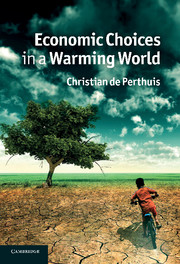Book contents
- Frontmatter
- Contents
- Acknowledgements
- Introduction
- 1 Climate risk
- 2 Some like it hot: adaptation to climate change
- 3 Building a low-carbon energy future
- 4 Pricing carbon: the economics of cap-and-trade
- 5 Intensifying agriculture to safeguard forests
- 6 The price of carbon: the economics of projects
- 7 Macroeconomic impacts: sharing carbon rent
- 8 International climate negotiations
- Conclusion
- References
- Appendix 1 Thirty key readings
- Appendix 2 Thirty key sets of figures
- Appendix 3 Greenhouse gas emissions around the world
- Glossary
- Index
Conclusion
Both action and inaction entail risks
Published online by Cambridge University Press: 05 June 2012
- Frontmatter
- Contents
- Acknowledgements
- Introduction
- 1 Climate risk
- 2 Some like it hot: adaptation to climate change
- 3 Building a low-carbon energy future
- 4 Pricing carbon: the economics of cap-and-trade
- 5 Intensifying agriculture to safeguard forests
- 6 The price of carbon: the economics of projects
- 7 Macroeconomic impacts: sharing carbon rent
- 8 International climate negotiations
- Conclusion
- References
- Appendix 1 Thirty key readings
- Appendix 2 Thirty key sets of figures
- Appendix 3 Greenhouse gas emissions around the world
- Glossary
- Index
Summary
The light is fast fading. The north wind is bitingly cold. But the chill does not discourage the many cyclists pedalling along the city streets. At the opera house by the town's docks they're getting ready for the evening performance. Behind its imposing roof, the last glimmer of daylight is reflected from the blades of the wind turbines offshore. We are in Copenhagen, a city where the environment is taken seriously.
A ship is inching its way under Oresund Bridge, which links Copenhagen to the Swedish city of Malmö. It is a bulk carrier, transporting coal loaded in Szczecin, Poland. It glides along the stretch of the Baltic Sea bordering the city, avoiding the wind turbines lined up like marker buoys in the water and berths behind the opera house. Its cargo is destined for Amagervaerket power station, situated midway between the opera and the wind farm.
The whole city is brightly lit. Light shining through the huge glass wall of the opera house casts multi-coloured glints across the water. Plumes of water vapour emerge from the three chimneys of the power station, now running at full capacity to meet peak demand for electricity.
From the Bella Center, the conference centre where the Copenhagen summit was held in December 2009, one can clearly make out the juxtaposed wind farm and thermal power station, symbols of tomorrow's and yesterday's worlds. What the negotiators discussed above all else were the options countries have in making the transition from yesterday's world to tomorrow's.
- Type
- Chapter
- Information
- Economic Choices in a Warming World , pp. 217 - 222Publisher: Cambridge University PressPrint publication year: 2011



